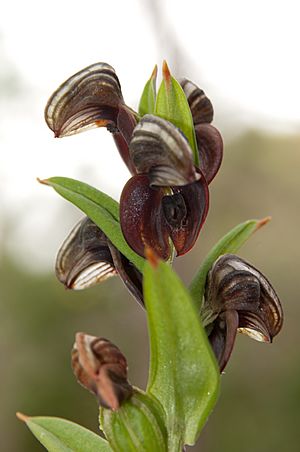Red-banded greenhood facts for kids
Quick facts for kids Red-banded greenhood |
|
|---|---|
 |
|
| Scientific classification | |
| Genus: |
Pterostylis
|
| Species: |
sanguinea
|
| Synonyms | |
|
|
The Pterostylis sanguinea, also known as the red-banded greenhood or dark-banded greenhood, is a special type of plant. It belongs to the amazing orchid family. This plant is endemic to southern Australia, which means it naturally grows only there.
These orchids can look different depending on the year. Some years, they have a group of leaves that form a circle, called a rosette. Other years, they grow a tall stem with leaves and flowers. When it flowers, it can have up to twelve blooms. These flowers are usually dark reddish-brown, but can also be green or a mix of green and brown. The top part of the flower forms a hood over its center. This orchid is quite common and can be found in Western Australia, South Australia, Victoria, and sometimes in Tasmania.
Contents
What Does the Red-banded Greenhood Look Like?
The Pterostylis sanguinea is a plant that grows from an underground part called a tuber. It is a perennial herb, meaning it lives for more than two years and its leaves die back each year.
Leaves and Stems
When the plant is not flowering, it has a rosette of leaves. There are usually three to ten leaves in this circle. Each leaf is about 20 to 40 millimeters (about 1 to 1.5 inches) long. They are also about 6 to 15 millimeters (about 0.2 to 0.6 inches) wide.
When the plant is ready to flower, it grows a tall stem. This stem can be 150 to 400 millimeters (about 6 to 16 inches) tall. It has six to ten leaves along its length. These stem leaves are about 20 to 50 millimeters (about 0.8 to 2 inches) long. They are also about 6 to 12 millimeters (about 0.2 to 0.5 inches) wide.
Flowers and Their Features
The flowers of the red-banded greenhood are quite unique. They are about 15 to 25 millimeters (about 0.6 to 1 inch) long. They are also 12 to 20 millimeters (about 0.5 to 0.8 inches) wide. The top part of the flower, made of the dorsal sepal and petals, creates a hood. This hood covers the central part of the flower, called the column.
The lower parts of the flower, called the lateral sepals, point downwards. They are about 11 to 14 millimeters (about 0.4 to 0.5 inches) long. These sepals are joined together for most of their length. The labellum is a special lip-like part of the flower. It is dark brown and looks a bit like an insect. It is about 6 millimeters (about 0.2 inches) long. This labellum can flick upwards if something touches it. These orchids usually bloom from June to September.
Where Does the Red-banded Greenhood Grow?
The Pterostylis sanguinea orchid is found in several parts of Australia. In Western Australia, it grows from north of Kalbarri all the way to Toolinna Cove in the east. You can also find it in the southeastern part of South Australia.
In Victoria, it grows in separate areas, west from Yarram. It is quite rare in Tasmania. There, it is only found in the Strzelecki National Park on Flinders Island. This orchid prefers to grow in forests and woodlands. It likes soils that drain water well.
Protecting the Red-banded Greenhood Orchid
The red-banded greenhood orchid is generally doing well in most places. The Government of Western Australia's Department of Parks and Wildlife says it is "not threatened." This means there are enough of them in the wild.
However, in Tasmania, it is a bit different. The orchid is considered "rare" under the Threatened Species Protection Act 1995. This means that in Tasmania, there are not many of these orchids left. Because of this, they need special protection to make sure they continue to grow there.


